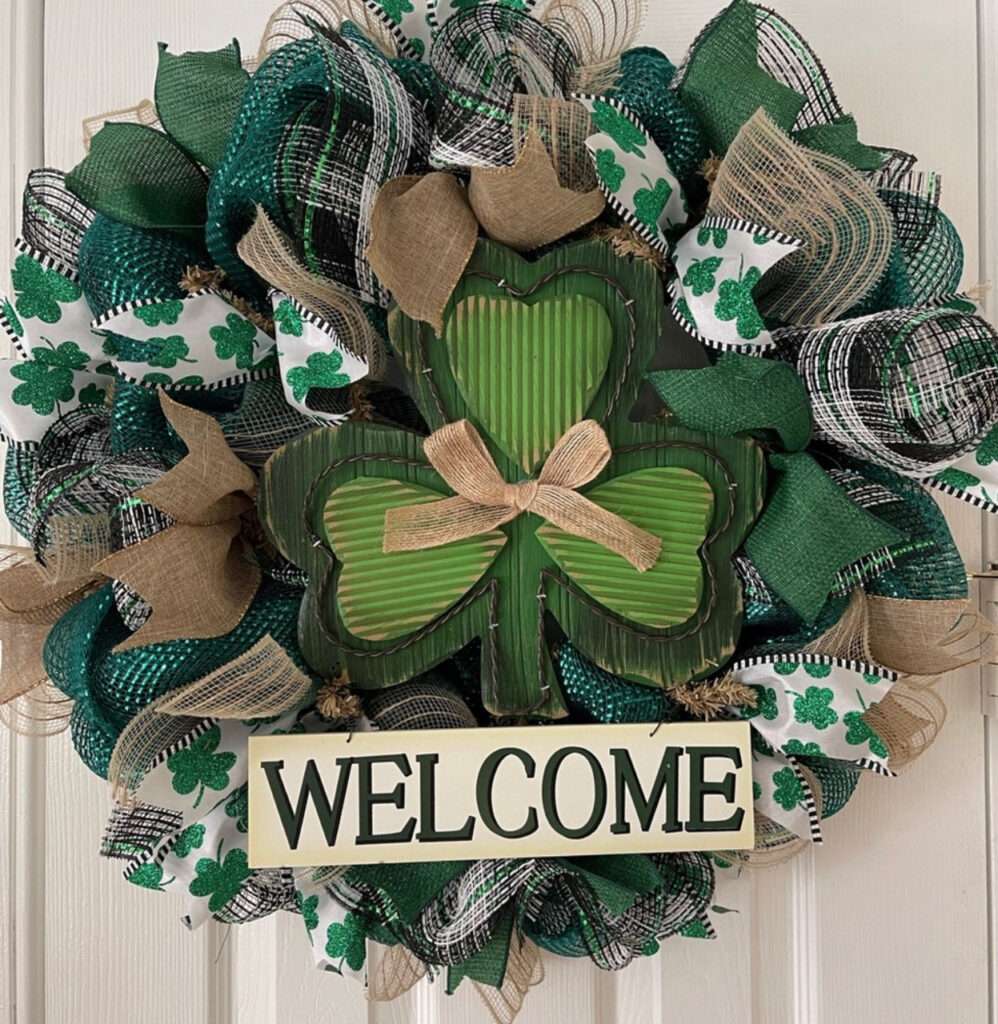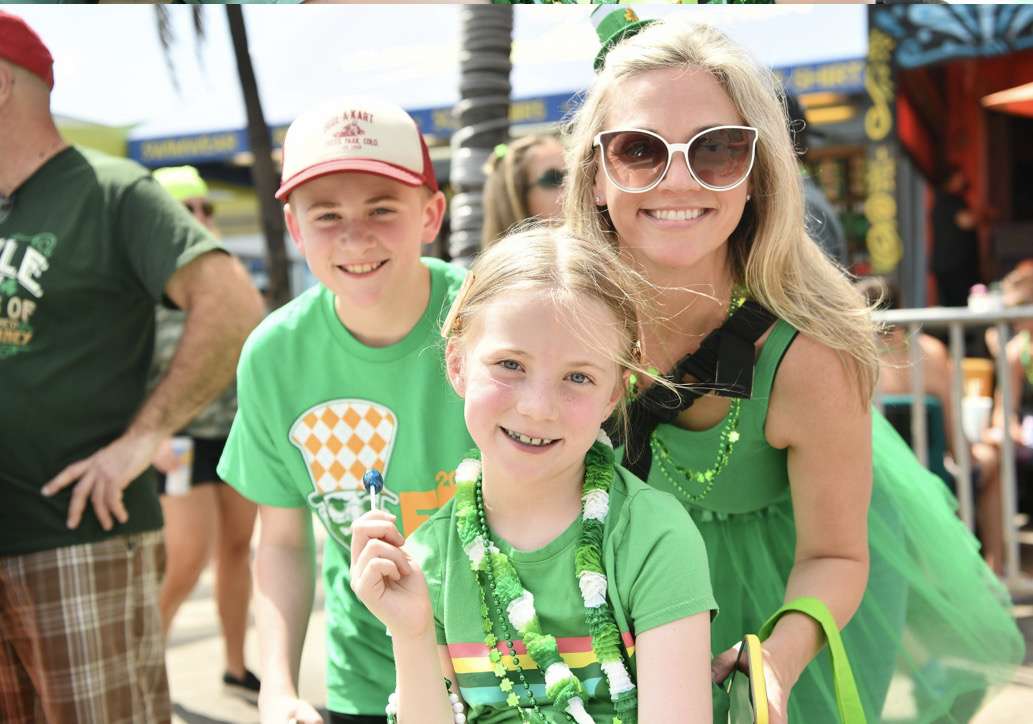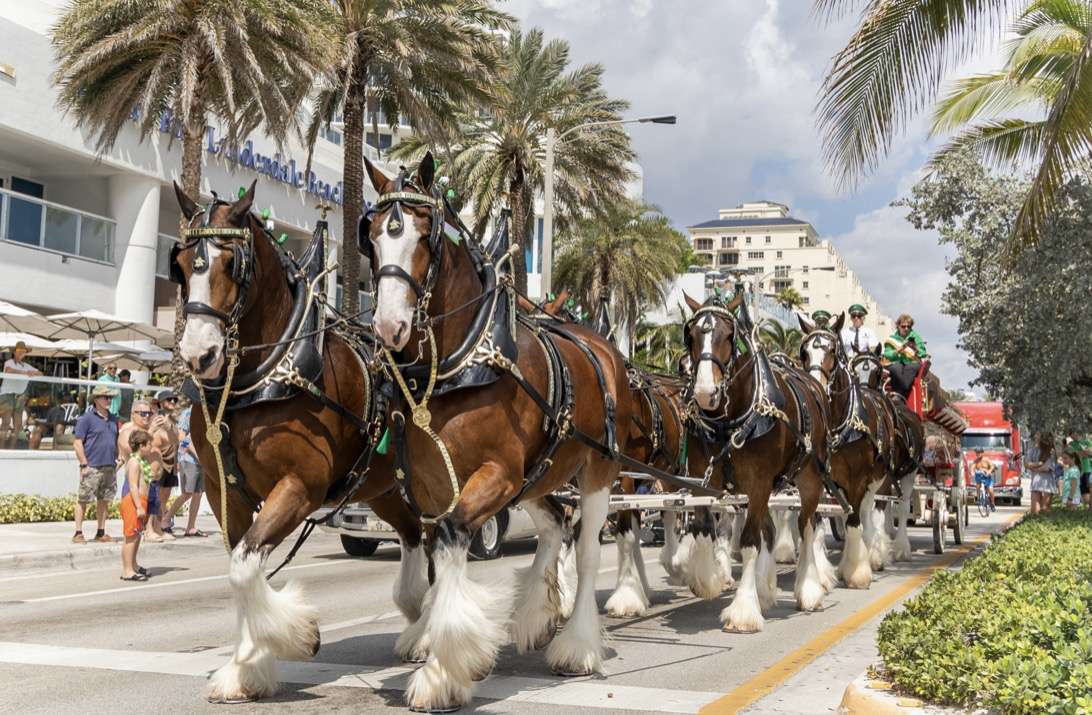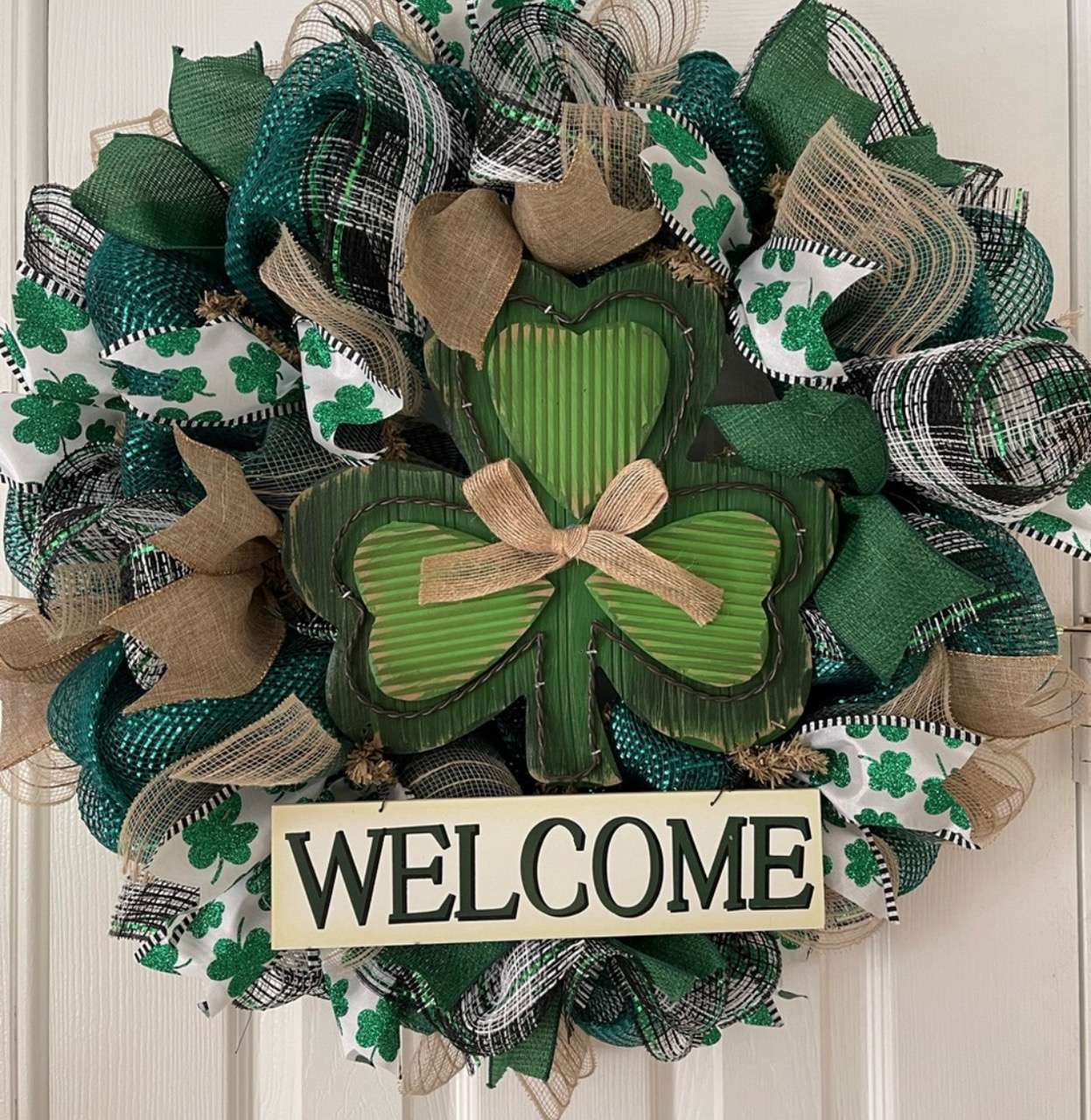
St. Patrick’s Day: Local Celebrations, Myths, Customs, Recipes and the FUN in just being Green
Posted on March 10, 2024 by Great Florida HomesBy Mindi Rudan
March 17, 2024. It’s a day when Irish and non-Irish alike come together in the fun, in the camaraderie just by the “wearing of the green”—or donning a shamrock or two, (the Irish national plant). Supermarkets advertise sales on Corned beef and cabbage – (the fare most commonly associated with the holiday), and even beer is sometimes dyed green to add to the festiveness of the day. Today, with some 35 million Americans claiming to be primarily or partially of Irish descent—making Irish ancestry the second-most commonly reported in the United States, after German—the wearing of the green on March 17 is still going strong. (Australia and Canada are among other locales with long-standing St. Paddy’s Day traditions.)
BUT…. if truth be told —the history of St. Patrick’s Day really isn’t that happy at all. (Please don’t kill the messenger!)
The day actually marks the death of St. Patrick, the patron saint of Ireland and is grounded in a history that dates back more than 1,500 years. The holiday was traditionally a more solemn occasion on the Emerald Isle—until Americans got involved. (Duh!)AND now St. Patrick’s Day HAS done a 180, morphing into a modern day celebration of epic proportions rich in both Irish heritage, folklore and culture (with a boatload of sheer blarney too) with parades all over the world, special foods, music, iconic symbols, (think Leprechauns), copious amounts of drinking, revelry and a whole lot of green everything!
Much of what we know about the actual life of St. Patrick has been interwoven with folklore, storytelling and plain legend. So here’s a buzz kill—historians generally agree on one thing: that St. Patrick, was actually born in Britain (not Ireland) near the end of the 4th century. At age 16 he was kidnapped by Irish raiders and sold as a slave to a Celtic priest in Northern Ireland. After toiling six years as a shepherd, outdoors and away from people he became increasingly lonely and afraid, thus turning to religion for comfort and solace and becoming a devout Christian.
After more than six years as a prisoner, Patrick escaped. And according to his own writing, a voice—which he believed to be God’s—spoke to him in a dream, telling him it was time to leave Ireland. To do that, Patrick walked nearly 200 miles from County Mayo, where it is believed he was held, all the way to the Irish coast. After escaping back to Britain, Patrick reported that he experienced a second revelation—an angel in a dream told him to now return to Ireland as a missionary. Soon after, he began his religious journey, studying more than 15 years and becoming a priest. After his ordination, he was sent to Ireland with a dual mission: minister to Christians already living in Ireland and begin to convert the Irish. (Interestingly, this mission contradicts the widely held notion that Patrick introduced Christianity to Ireland.) Another buzz kill—He did not.
There’s enough blarney in this world. So here’s some interesting FACTS to set the St. Patrick’s Day record straight.
St. Patrick Was Never ACTUALLY Canonized as a Saint
(I repeat: please don’t kill the messenger!) He may be known as the patron saint of Ireland, but Patrick was never actually canonized by the Catholic Church. This is probably just due to the era he lived in. During the first millennium, there was no formal canonization process in the Catholic Church. After becoming a priest and helping to spread Christianity throughout Ireland, Patrick was likely “proclaimed” a saint by popular acclaim thus the Saint in St. Patrick’s Day is more like “it’s the thought that counts” than the actual “title.”Snakes BE GONE??
Again, no. One long believed legend associated with St. Patrick is that he stood atop an Irish hillside and boldly banished snakes from Ireland—prompting all the serpents on the land to slither away into the sea. Truth? Nope. Research indicates that in fact snakes never actually occupied the Emerald Isle in the first place. There are no known signs of snakes in the country’s fossil record at all. And in fact, water has completely surrounded Ireland since the last glacial period. Before that, the region was covered in ice and would have been too cold for the reptiles. So while this legend is a goody, it is in fact complete hooey.Blue hoo, Green WASN’T the original St. Patrick’s Day color
The Irish countryside may be 50 shades of emerald green, but knights in the Order of St. Patrick actually wore a color known as St. Patrick’s blue. So how DID green become so emblematic of the St. Patrick holiday? The association probably dates back to the 17th century, the color was used during the Great Irish Rebellion of 1641 when supporters of Irish independence used the color green to represent their cause. Or the Emerald in the Emerald Isle? Or the limey green in shamrocks? But it was originally true blue!Corned beef is a classic St. Patrick’s Day dish
Well …. Yes AND no. On St. Patrick’s Day, countless modern revelers in the United States, Canada and elsewhere savor plates piled high with steaming slices of succulent corned beef and cabbage. In Ireland, however, not so much! Actually a type of bacon similar to ham is the customary protein on their holiday table. So why we in the US think corned beef and cabbage is the iconic meal?? In the late 19th century, Irish immigrants in New York City’s Lower East Side supposedly substituted corned beef, which they bought from their Jewish neighbors, in order to save money. (yup! JEWISH corned beef!!) That’s not to say salt-cured beef isn’t a traditional Irish dish; pork, however, has historically been more widely available on the Emerald Isle. (OY!!! Or ERIN GO…. ZBARS??!!)Luck of the Irish? Is a Shamrock considered the Irish Lucky Charm?
Well, while the shamrock, (which is actually a lovely plant whose cousin we find in our lawns in South Florida) is a three-leaf clover, and that symbol has been associated with Ireland for centuries. It was called the “seamroy” by the Celts and was considered a sacred plant that symbolized the arrival of spring. According to lore, St. Patrick used the plant as a visual guide when explaining the Holy Trinity — you know, the Father, the Son and the Holy Ghost. But by the 17th century, the shamrock had become a symbol of emerging Irish nationalism which for the Irish was indeed lucky. So as the English began to seize more and more Irish land and make laws against the use of the Irish language and the practice of Catholicism, many Irish began to wear the shamrock as a symbol of their Irish pride in their heritage and their mounting resentment of English tyranny and rule.But the four-leaf clover?? It is simply a rarer variation of the common three-leaf clover. And since it is rarer than the three leaf, “luck” was attributed to finding one and that has morphed into the 4-leaf being Uber “lucky”. Just to set the record straight: There are approximately 10,000 three-leaf clovers for every “lucky” four-leaf clover. So just for the record: There are NO clover plants that naturally produce four leaves, which is why finding the four-leaf anomaly is considered lucky. Some folk traditions assign a different attribute to each leaf of a clover. The first leaf represents hope, the second stands for faith, the third is for love and the fourth leaf brings luck to the finder.
Leprechauns
One of the most iconic symbols of the Irish holiday has to be the Leprechaun. The original Irish name for these legendary figures is “lobaircin,” meaning “small-bodied fellow.” Belief in leprechauns probably stems from the Celtic belief in fairies, tiny men and women who could use their magical powers to serve good or evil. (Not necessarily to hawk soap or breakfast cereal).In Celtic folktales, leprechauns were cranky little souls, responsible for mending the shoes of the other fairies. Though only minor figures in Celtic folklore, leprechauns were known for their trickery, which they often used to protect their much-fabled treasure. Leprechauns have their own holiday on May 13, but are also celebrated on St. Patrick’s Day, with many dressing up as these mischievous little fairies.
CHEERS?? Ah, St. Patrick’s Day was actually a DRY HOLIDAY in Ireland!!
Who woulda “thunk” it? Although St. Patrick’s Day was recognized on their religious calendar as a feast day for centuries, it wasn’t actually recognized by the British government as a national bank holiday in Ireland until 1903—and it wasn’t until the 1970s that the holiday became synonymous with “imbibing” at least in Ireland where pubs were previously closed for the holiday. Drinking was much more of a fixture in American celebrations of the holiday, starting as early as the 18th century. In the early 1900s, drinking green beer instead of the normal amber stuff started becoming a part of the festivities in the US—but the term might’ve caused some confusion at first. In the late 1800s, “green beer” was a term for a beverage that hadn’t fully fermented thus giving the beer a bad taste and causing stomach upset. Today food coloring is added to the beer so the only thing the partier has to worry about is the hangover the next day!So besides shamrocks, beer and leprechauns, Irish soda bread is one of THE iconic ways to feast on this festive day. Here’s one of the easiest, most delicious (toasted for breakfast with butter or hot from the oven) ways to savor this glorious day.
Ingredients:
1 cup quick-cooking oats (not instant), plus extra for sprinkling
2 1/4 cups whole wheat flour
1/4 cup all-purpose flour
1/2 cup dark brown sugar, lightly packed
2 1/4 teaspoons baking soda
1 teaspoon baking powder
2 teaspoons kosher salt
1 (11- to 12-ounce) bottle Guinness extra stout beer, at room temperature
1 cup buttermilk, shaken
5 tablespoons unsalted butter, melted, plus extra for brushing the pan
1 teaspoon pure vanilla extract
Salted butter (not margarine)
1 cup raisins or dried currants – optionalDirections
Preheat the oven to 450 degrees.
In a large bowl, combine the oats, whole wheat flour, all-purpose flour, brown sugar, baking soda, baking powder, and salt.
In a separate bowl, whisk together the beer, buttermilk, melted butter, and vanilla. Make a well in the dry ingredients and pour the wet ingredients into the well. With your fingers, stir the batter from the middle of the bowl to the outside, until it’s well mixed. It will look more like cake batter than bread dough. Add fruit if using. Mix in.
Brush a 9 x 5 x 2 1/2-inch loaf pan with melted butter. Pour the batter into the pan and sprinkle the top with oats.
Put the bread in the oven, immediately turn the temperature down to 400 degrees, and bake for 45 minutes, until a toothpick comes out clean. Turn the bread out onto a baking rack and allow to cool completely.
Slice and serve with REAL butter before you head out to some of the great St. Pats celebrations locally.PARADE Anyone??
If you’ve ever been to New York City over St. Patricks’s day, no matter where you are in the city you can feel the electricity that the iconic parade creates. But actually whether you’re in Dublin, Galway, New York, Boston, Chicago or any town in between that is steeped in Irish heritage, the St. Patrick’s day parade is one of the most enjoyable parts of the Irish holiday.And you’d think IRELAND is where this “tradition” began. But nope. Surprisingly, the first recorded St. Patrick’s day parade in history actually took place in New York City on March 17th, 1762. It was held by Irish soldiers who were serving in the British army. They marched to Irish music to help them reconnect with their Irish ancestry and fellow servicemen. Since then, the St. Patrick’s day parade has become an annual tradition in both the big apple and many other parts of the globe.
(The St. Patrick’s day parade didn’t actually make it’s way to Ireland until 1931, when the first parade was held in Dublin). Since then, it has turned into a five-day, activity-filled St. Patrick’s festival, consisting of food, music, theater, and even fireworks. Ireland may have gotten to the party a bit late, but they’ve made up for it by creating the biggest St. Patrick’s day parade, er, celebration, in the world. If you’re planning a trip to Ireland in mid-March, the St. Patrick’s festival is a once in a lifetime experience that you certainly won’t want to miss.
If you’re in NYC, the parade is actually Sat, Mar 16th from 11-AM – 4:30 PM. The Parade begins on 5th Avenue at 44th Street and ends on 5th Avenue at 79th Street and the “GRAND MARSHALL” this year is MARGARET C. TIMONEY. “Maggie” Timoney is the President & CEO of HEINEKEN USA.
But if you’re staying put in SoFla, you can still experience one of the largest St. Patrick’s Day parades in the country at the HOLLYWOOD ST. PATRICK’S DAY PARADE & FESTIVAL on March 10th! Over a mile in length – you’ll see some of the most exciting performers, festive floats, antique vehicles, marching bands, & more!!
All the way from the Big Apple – Don’t miss the NYPD Emerald Society Pipe and Drum Corps as they lead the processional east down Hollywood Boulevard, through Young’s Circle, and back up Harrison Street, to Dixie Highway! Live performances all day at the main stage, located at 19th Ave & Hollywood Boulevard. Sing along with your Irish Folk favorites & catch amazing performances with Uproot Hootannny & the always incredible U2 by UV! Get lucky and score some one-of-a-kind finds shopping at the 80+ unique vendor booths that line the streets of Downtown Hollywood! And maybe stop for a pint (or two) at Mickey Byrne’s Irish Pub & Restaurant. www.
stpatricksfestival.com On Saturday, March 16th from noon – 5 PM head to Delray Beach for the 54th Annual St.
Patrick’s Day Parade and Festival in downtown Delray Beach. The Parade (12-2 pm on Atlantic Ave. from the intracoastal bridge to NW 5th Ave.) features over 70 entries including fire departments from around the world, United States Veterans, Pipes and Drums, floats, schools, businesses, and more. And the Grand Marshal of 2024? The incredible Women Veterans of the U.S. Armed Forces! Join in honoring these brave women for their unwavering commitment to freedom and celebrate their remarkable service! Then head over to the Festival (1-5 pm) at Old School Square (51 N. Swinton Ave). The festival is a FREE, family-friendly event that boasts live music, Irish step dancing, strolling bagpipers, food and merchandise vendors, bounce houses, and so much more! This year enjoy LIVE music by The Prodigals, an Iconic, family-friendly band mixing Irish traditional and original music, world rhythms, and NYC energy. Vocals, accordion, acoustic guitar, percussion, flute, and hard-shoe rhythmic dance. https://stpatsdelray.com/(561-243-7250) Not to be outdone you can also head over to the Fort Lauderdale St. Patrick’s Parade and Festival on Saturday, Mar 16 from 6am – 3pm. This event draws thousands of spectators to the streets of downtown, for a one-of-a-kind celebration of all things Irish.
The Festival starts at 10am-7pm at Tunnel Top Plaza, Las Olas Boulevard and SE 6th Avenue. They’ll be Live Music, Interactive Games, a Kids Zone, Food and Beverages, Cultural Activities & more! The Parade (12-2pm) offers tons of decorative floats, bagpipers, marching bands, street performers, classic automobiles, and merry revelers will travel east on Las Olas Boulevard from Huizenga Plaza to SE 9th Avenue.
https://lasolasboulevard.com/
event/fort-lauderdale-st- patricks-parade-festival-2024/ Add in the IRISH pubs and local restaurants all over south Florida you can find fun, food and frolic on this day, and unlike what Kermit espoused, it’s really not hard being green, at least when celebrating St. Patrick! So go ahead, paint the town green.
Happy St. Patrick’s Day.
Mindi Rudan is a semi-retired writer living in Parkland with her husband and houseful of 4-legged fur babies and is the former publisher and founder of Parkland Life, Coconut Creek Life and BocaDelray Life Magazines and the former chair of the Parkland Chamber and Coconut Creek Chambers of Commerce. A sometime event planner, she makes handcrafted custom wreaths, bakes, gardens and writes occasional blogs, articles or custom social media content.







